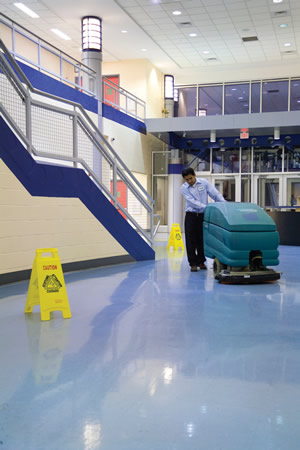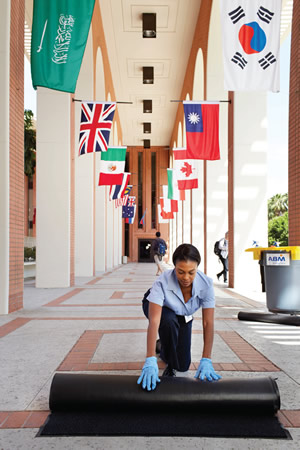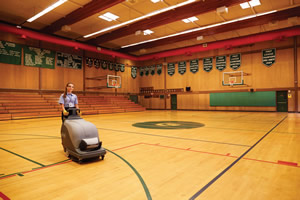Floors Need Special Care
- By Gordon Buntrock
- 06/01/19

PHOTO COURTESY OF ABM
Floors provide a real impression regarding what you want people to think about the institution. The rest of your facility can sparkle, but if your floors or carpets look worn or dirty, they can send the wrong message to visitors, students, and staff about the ability to fund the institution, or the ability to provide quality programs or education.
Maintaining the quality of floors, start where the dirt and soil enter your buildings, the entrances and foyers. Eighty percent of the soil and moisture comes in through your entrances. I’m sure you’ve all heard the Benjamin Franklin axiom, “An ounce of prevention is worth a pound of cure.” In floor care, the ounce of prevention is a good matting program.
Entryway Matting: If you don’t have special matting at your entrances, this is something you should seriously consider. The rather small investment will pay for itself because floors will be protected and require less care. If you do have matting, periodically have it inspected and deep cleaned. Both scraper matts on the exterior of the building and scraper and absorbent matting can capture these soils and stop them from destroying your floors. Regardless of your climate or environment, entrance matting through a well-designed plan can be an attractive addition to your flooring design, reduce labor costs of maintenance, and provide extended life and beauty to your floors throughout the building.
Routine Maintenance of Your Floors
All things are relative. So, when it comes to daily soil load on your floors, some soil comes from foot traffic or the users of the building, and the other soil comes from atmospheric deposition or the airflow through your building. The higher the volume the greater frequency required. This starts with basic dry soil removal. The typical dry soil removal on carpeting comes in the form of vacuuming. The Carpet and Rug Institute has a rating system evaluating various types of vacuums in the industry based on their ability to remove soil. Some carpet manufacturers say that a system with a beater bar is required, however, the higher quality of carpeting today with high densities, improved fibers, and level loop patterns can be maintained sufficiently on the dry soil removal as long as the frequency matches the traffic load. So, when the building is occupied daily, vacuum it daily. If you have a very high density of population to building square footage, it may require multiple times per day.

PHOTO COURTESY OF ABM
Hard surface floors have multiple methods for dry soil removal. The typical dust mop can be selected, or microfiber dust mops, or vacuum sweepers, or even back pack vacuums. The though is to remove it before it gets ground into the floor. Frequency for dry soil on hard-surface floors is the same as carpeting. Match the frequency of dry soil removal to the volume of traffic and soil load.
Wet soil removal is the next process in routine maintenance of your floors. On carpeting, complete wet cleaning of carpets on a daily basis is not practical, either from a cost standpoint or from a care standpoint for the fibers. However, daily spotting of carpeting is essential to proper carpet and carpet longevity. Although carpet fibers have become more stain resistant in more recent years, there are still those that can cause permanent staining, that if taken care of in an expedient manner, can be removed with little effort. On hard surface floors, spot mopping can be used to remove spills and stains, but in many locations daily wet mopping is utilized to pick up spills and soils through the entire surface or production machinery is used that can do the entire area with greater efficiency and thoroughness compared to a spot mop process.
Periodic or Restorative Maintenance for Floors
On carpeting, this needs to take place to eliminate deeply embedded soils or stains. This can take place as little as once per year and is based on the ability to properly maintain or provide the preventive and routine maintenance throughout the year. Even the best carpets get to a point where deep cleaning is required. Expertise and quality equipment and processes are needed to do this properly. They should spot clean first, using appropriate methods and products for the type of stain and fiber. Vacuuming or pile-lifting comes next, because removing dry soil and separating pile produces better results, faster. Hot water extraction is best for cleaning as this is usually the most effective method recommended by carpet manufacturers. The process includes pre-spraying with detergent, applying water under pressure and extracting water with a heavy vacuum. Air blowers should be used if needed for drying, and then the nap should be set.
Hard surface floors cover a plethora of materials and methods when it comes to periodic or restorative maintenance. These include, resilient floors (vinyl, rubber, Vinyl composition, luxury vinyl, no finish vinyl, vinyl asbestos, linoleum, polyester, wood, etc.) and non-resilient floors to include (stone, terrazzo, ceramics, porcelain, concrete, epoxy, etc.)
Each of these surfaces requires a certain level of periodic or restorative care and each varies based on traffic and soil load. No carpet or hard surface floor can be put onto a calendar for a must do periodic or restorative process. It is all based on the evaluation of soil load, the existing wear and condition of that floor at that particular point in time.
Superior preventive and routine maintenance process, weather conditions, and building usage can increase or decrease the length of time between needed periodic maintenance processes. This can only be done with expertise in the area of the flooring materials and evaluating the condition of the floor.
Stone: Though stone is quite indestructible, it is still susceptible to stains, scratches, cracks and other damage from normal wear, the environment and improper cleaning. Luckily, stone floors can usually be returned to their natural beauty, and it typically costs less to properly maintain than to replace them. Let an experienced professional look at your situation and recommend how to renew your stone. The process might involve cleaning; grinding, sanding, honing and/or polishing; buffing; sealing; stain and scratch removal, repairing, resetting or replacing tiles; and re-grouting.
Some resilient and non-resilient surfaces are maintained with a coating or finish, that either needs to have small layers of the coating removed and additional coats added, or these coatings needs to be completely removed due to scratches or staining that require total restoration or removal and a reapplication of the protective coatings. The professional evaluation is what determines what level of care is required to bring back the quality look of the coated surface.
Flooring today, has changed dramatically in its technology with claims of sustainability and durability that require a special knowledge of chemistry and processes to maintain. Flooring manufacturers are claiming low maintenance, reduced maintenance, maintenance free, and no coating required. It requires a unique expertise to sort through the manufacturers’ claims and consult on the materials that truly represent a low maintenance flooring product, reducing overall maintenance cost while providing an aesthetically pleasing and long-lasting floor.

PHOTO COURTESY OF ABM
Looking good. Specialty cleaning and restoration is a science and an art. It requires a service provider that uses the most effective techniques, along with sustainable practices and products, to ensure the best results on your specific materials and finishes. Taking care of your carpets and floors protects your investment, your image, and anyone customer stepping foot into your facility.
Wood and/or gym surfaces require special products and procedures particularly when it comes to periodic care. Special brushes, buffers, pads or discs can be used to clean, and remove coatings. Once repaired, sanded, re-stained, and coated with a protective finish, the wood will look and perform like it did when it was new. A well-maintained floor will perform better for athletes, while impressing spectators and visitors.
1. Improve Your Image: We’ve all seen the difference between a dirty carpet and a freshly cleaned one or a scratched floor and a refinished one. Wow, right? Refreshed floors and carpets go a long way in improving the aesthetic of your space.
Whether you have stone, wood, laminate, carpeting or other flooring material, is it stained, scratched, shoe-marked, worn, dull, cracked? You might not even realize how bad it has become. But with the right preventive, routine, periodic or restorative methods, the existing flooring can often be preserved and renewed for far less cost than replacing.
2. Accident/Illness Prevention: Taking a close look at your exterior and interior floors and stairs, you may find areas that need maintenance or repair, such as uneven tiles, torn or rippled carpets, or broken pieces that could be dislodged. In addition, mold and mildew in carpeting can cause illness. All of these pose safety risks that should be addressed…and could go unnoticed without the extra attention paid during a deep cleaning.
3. Extend Floor Life: Proper preventive, routine, periodic/restorative maintenance of floors can extend flooring material life and, thereby, save money in the long run.
A well-maintained floor will perform better for athletes, while impressing spectators and visitors.
Beauty Takes Effort but Pays Off
Specialty cleaning and restoration is a science and an art. It requires a service provider that uses the most effective techniques, along with sustainable practices and products, to ensure the best results on your specific materials and finishes.
Taking care of your carpets and floors protects your investment, your image, and anyone stepping foot into your facility.
This article originally appeared in the School Planning & Management June 2019 issue of Spaces4Learning.